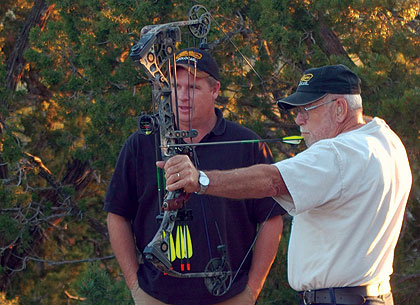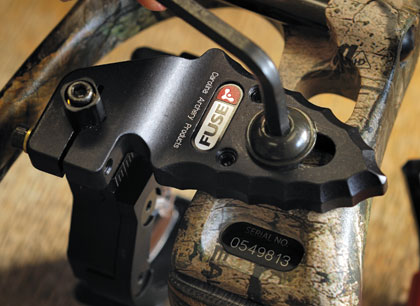May 13, 2011
By Bill Winke
I'm going to cover all the things I look for when evaluating new bows to find the ones I want to use for hunting.
By Bill Winke
 Always test shoot a bow before you buy it. There is much you can learn about the bow during this process that will impact how well you shoot it later. |
In the April/May issue, I wrote the Great Bows feature. In the course of the discussion, I found myself touching on a few things I look for when I test fire a bow. There is a lot more to selecting a bow than many readers realize. Marketing may bring a particular bow to the forefront of our minds, but more tangible qualities should govern our actual purchase. In this column, I'm going to cover all the things I look for when evaluating new bows to find the ones I want to use for hunting.
You can start with the specs, but specs will only get you so far. Numbers will never tell you how a bow feels or sounds or how it reacts in your hand. I will touch briefly on the numbers, but then I'll move quickly into the real heart of this project — how the bow feels and shoots.
Advertisement
| Video: Selecting a New Bow | 

|
|
Understanding the Specs
I always look at the speed rating, the brace height and the axle-to-axle length. I can tell quite a bit about a bow from these three numbers.
IBO Speed Rating: If the IBO speed is above 310 feet per second, the bow is fast enough for most anything you care to throw at it. Sure, a faster bow is always welcome — as long as you don't have to give up too much to get it (more about that later). The IBO rating is the speed you get when you shoot the bow at 30 inches of draw length and 70 pounds of draw force with a 350-grain arrow. It is not a true hunting speed, because that arrow is just too light for most situations. Plus, most bowhunters have draw lengths shorter than 30 inches, and many have draw weights lower than 70 pounds. Despite that, the IBO rating (if done honestly) is a good basis for comparing bow speed from one make and model to the next.
Advertisement
You can find IBO speeds as high as 360 fps. That is amazing. I have shot these bows and they are not particularly offensive. So, it is worth at least keeping them on the list. Anything with an IBO from 310-330 fps potentially falls into the category of forgiving bows, while anything over 330 fps should be considered an all-out burner. If you are going to buy a bow in the 330+ fps range, you should have a better reason than just the desire to have the fastest bow on the block. You should have a legitimate need for such speed — and good shooting form. Super-fast bows are that way for three reasons: they have aggressive, hard-to-pull cams; they have a low brace height; and they have very efficient cam designs. Efficiency is good, but the other two factors can make the bow less forgiving and/or less enjoyable to shoot. So, there are tradeoffs. Bows keep improving every year and they are now better at combining speed with accuracy. As a result, they create better arrow flight; an arrow that is flying straight will always be more accurate at higher speeds than one that is whipping around. So, these tradeoffs are found in varying shades of gray, not in black and white. Again, it is going to come down to shooting the bow.
Brace Height: Brace height is the distance from the back of the grip to the string when the bow is at rest. A bow with a low brace height is typically thought to be less forgiving than the same type of bow with a higher brace height. But it is not that simple. In truth, forgiveness is related to the amount of time the arrow is on the string. A bow with a fast string and low brace height may actually be slightly more forgiving than a bow with a higher brace height but a slower string. It is similar to lock time with a firearm; the longer it takes from trigger pull to the time when the bullet is out of the barrel, the better your form needs to be to shoot the gun accurately. While we may be splitting hairs here, it is at least worth considering brace height. I prefer a brace height of 7 inches or greater, though that is not a hard and fast rule. Again, you have to shoot the bow to know.
Axle-To-Axle Length: This is going to be another exercise in splitting hairs, based as much on physics as on actual testing. Short bows are potentially less stable because their rotational inertia is less. It is a fancy way of saying that short (and light) bows are easier to move quickly than longer (and heavier) bows. Thus, the longer bows are potentially more stable in the hand and more accurate at longer distances than shorter bows. If you have good form with a nice, consistent follow-through, you won't really notice much difference. Most people don't care about this tradeoff, or it is not perceived as important, because short bows are very popular. Personally, I still like the mid-sized bows.
 When test shooting a bow, do so with only a full-capture style rest installed. That way, you can be sure whatever noise you hear is coming from the bow. |
So, you have to consider all these tradeoffs when evaluating bows. There are many fine models in both the forgiving category and the raw speed category. If your form is good and you practice regularly, you will do fine with a bow from either group.
Shooting the Bows
After you've considered the numbers, you definitely have to shoot the bows. Here is what to look for.
Grip: When you draw the bow, the first thing you will feel is the grip. Grips used to be crummy, wide and square. A bow was notable if it had a great grip. That has definitely changed, because most bows have very good grips. But not every grip is perfect for every bowhunter. When you draw the bow, make a conscious effort to sense how the grip feels in your hand. It has to be comfortable or you will never be able to relax your bow hand enough to shoot properly. The best grips are narrow so they focus pressure on just a small part of the hand, reducing torque on the bow.
Noise: There are some very quiet bows on the market. You should not have to suffer with a noisy bow just to get speed. If the bow is loud and buzzing, first be sure it is not the accessories. Twang the string four or five inches and listen for vibration. If the accessories have a loose part, you will hear it quite easily.
The best way to determine if a bow is noisy is to shoot it with only a Whisker Biscuit and nocking point attached. These have no moving parts. Any noise you hear is almost certainly from the bow itself. Two bows of the same model can sound different. So, try a couple before you give up on a certain model.
Vibration and Recoil: With the parallel limbs readily available on today's bows, there is no good reason to endure a bow that jumps dramatically in your hand. Some recoil is unavoidable and is actually useful, but a heavy dose of forward jump is unpleasant. It is a similar story with vibration. You should not feel excessive vibration in your hand after the shot.
Forward jump: As I mentioned, light recoil is actually beneficial. I like my bows to jump just a bit in my hand because that tells me what they are doing while the arrow is still on the string. It gives me feedback on my shooting form. But sometimes it is the bow itself that is messed up. I have shot a number of bows that turned in my hand after the arrow took flight. A few were actually pointing 45 degrees to the side. What the bow does after the arrow leaves is what it was starting to do while the arrow was still on the string. Shoot each bow with a soft, fully relaxed bow hand and make a point to sense where the bow goes after the arrow leaves. It should follow the arrow straight toward the target. If it doesn't, try another model. If you can't find any bows that stay on target, your grip is probably at fault.
Visual Inspection
Before buying a bow, sight down the string to make sure the string lines up with the cams or cam and idler wheel. If a cam leans relative to the string, the string will take a sideways course as you draw and release. This creates poor arrow flight that is very hard to fix.
Conclusion
You need a set of criteria to use when evaluating a new bow for possible purchase. The numbers will tell you part of the story, but to really determine whether a bow is a sweet shooter that fits your style, you have to shoot it at least a dozen times. Buying a bow is a big investment, but you can eliminate most of the risk by carefully putting it through its paces before writing the check.
